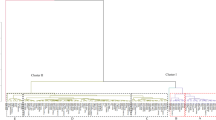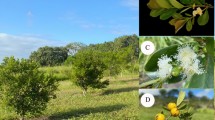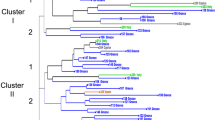Abstract
Sixteen pomological traits were employed to characterize the diversity of 30 fig accessions collected mainly from Southeastern Tunisia and maintained at CFPA ‘El Gordhab’, Tataouine, in Southeastern Tunisia. Additionally, 13 simple sequence repeat (SSR) loci were analyzed to detect the genetic diversity of the 30 fig accessions. In this study, qualitative data (fruit shape, fruit external color, fruit internal color, abscission of the stalk from the twig, skin peeling, fruit skin firmness) showed morphological variation within accessions. A highly significant difference (p < .01) among accessions was revealed for all the quantitative traits. The first three components (PC1, PC2, and PC3) of PCA accounted for 52.99% of the total variability. PC1, PC2, and PC3 accounted respectively for 28.02, 13.05, and 11.91% of the total variance. The most discriminating morphological parameters were fruit length and diameter, stalk length and diameter, neck length and diameter, stalk and flesh thickness, fruit shape, skin peeling, and skin firmness. Concerning the molecular results, 40 alleles were revealed. The number of alleles ranged between 2 to 6 with a mean of 3.08 alleles per locus. The observed heterozygosity (Ho) ranged from 0.03 (LMFC21, LMFC23, and LMFC32) to 0.83 (LMFC30) with an average of 0.43. The expected heterozygosity (He) varied from 0.03 (LMFC21, LMFC 23 and LMFC32) to 0.74 (LMFC30) with an average of 0.37. UPMGA cluster analysis and PCA grouped the accessions in 6 groups. Our results showed that the SSR markers used detected low genetic diversity within the accessions studied.




Similar content being viewed by others
References
Duenas M, Perez-Alonso JJ, Santos-Buelga C, Escribano-Bailon T (2008) Anthocyanin composition in fig (Ficus carica L.). J Food Comp Anal 21:107–115
Almajali D, Abdel-Ghani AH, Migdadi H (2012) Evaluation of genetic diversity among Jordanian fig germplasm accessions by morphological traits and ISSR markers. Sci Hortic 147:8–19
Ercisli S, Tosun M, Karlidag H, Dzubur A, Hadziabulic S, Aliman Y (2012) Color and antioxidant characteristics of some fresh fig (Ficus carica L.) genotypes from northeastern Turkey. Plant food hum. Nutr 67:271–276
Aljane F, Neily MH, Msaddek (2020) Phytochemical characteristic and antioxidant activity of several fig (Ficus carica L.) ecotypes. Ital J Food Sci 32:736–749
Pereira C, Martín A, López-Corrales M, de Guía CM, Galván AI, Serradilla MJ (2020) Evaluation of the physicochemical and sensory characteristics of different fig cultivars for the fresh fruit market. Foods. https://doi.org/10.3390/foods9050619
Rubnov S, Kashman Y, Rabinowitz R, Schlesinger M, Mechoulam R (2001) Suppressors of cancer cell proliferation from fig (Ficus carica) resin: isolation and structure elucidation. J Nat Prod 64:993–996
Lansky EP, Paavilainen HM, Pawlus AD, Newman RA (2008) Ficus spp (fig): ethnobotany and potential as anticancer and anti-inflammatory agents. J Ethnopharmacol 119:195–213
Wang J, Wang X, Jiang S, Lin P, Zhang J, Lu Y, Wang Q, Xiong Z, Wu Y, Ren J, Yang H (2008) Cytotoxicity of fig fruit latex against human cancer cells. Food Chem Toxicolo 46:1025–1033
Oliveira AP, Valentão P, Pereira JA, Silva BM, Taveres F, Andrade PB (2010) Ficus carica L.: metabolic and biological screening. Food Chem Toxicol 47:2841–2846
Raskovic B, Lazic J, Polovic N (2015) Characterization of general proteolytic, milk clotting and antifungal activity of Ficus carica latex during fruit repening. J Sci Food Agric 96:576–582
Melekşen A, Danijela P, Peral ES, Tim W, Gürsel Ö, Sezai E (2020) Molecular characterization of fig (Ficus carica L.) germplasm from northeastern Black Sea region. Genetika 52:411–420
Caliskan O, Polat AA (2008) Fruit characteristics of fig cultivars and genotypes grown in Turkey. Sci Hortic 115:360–367
Şimşek M, Yildirim H (2010) Fruit characteristics of the selected fig genotypes. Afr J Biotechnol 9:6056–6060
Gozlekci S (2011) Pomological traits of fig (Ficus carica L.) genotypes collected in the West Mediterranean region in Turkey. J Anim Plant Sci 21:646–652
Caliskan O, Polat AA, Celikkol P, Bakir M (2012) Molecular characterization of autochthonous Turkish fig accessions. Span J Agric Res 10:130–140
Caliskan O, Bayazit S, Ilgin M, Karatas N (2017) Morphological diversity of caprifig (Ficus carica var. caprificus) accessions in the eastern Mediterranean region of Turkey: potential utility for caprification. Sci Hortic 222:46–56
Ciarmiello LF, Piccirillo P, Carillo P, De Luca A, Woodrow P (2015) Determination of the genetic relatedness of fig (Ficus carica L.) accessions using RAPD fingerprint and their agro-morphological characterization. S Afr J Bot 97:40–47
Papadopoulou K, Ehaliotis C, Tourna M, Kastanis P, Karydis I, Zerkavis G (2002) Genetic relatedness among dioecious Ficus carica L. cultivars by random amplified polymorphic DNA analysis, and evaluation of agronomic and morphological characters. Genetics 114:183–194
Oukabli A, Mamouni A, Laghezali R, Khadari B, Roger JP, Kjellberg F, Ater M (2002) Genetic variability in Morrocan fig cultivars (Ficus carica) based on morphological and pomological data. Acta Hortic 605:54–60
Messaoudi Z, Haddadi L (2005) Morphological and chemical characterization of fourteen fig trees cultivated in Oulmes area, Morocco. Acta Hortic 798:83–86
Hssaini L, Hanine H, Razouk R, Ennahli S, Mekaoui A, Ejjilani A, Charafi J (2019) Assessment of genetic diversity in Moroccan fig (Ficus carica L.) collection by combining morphological and physicochemical descriptors. Genet Resour Crop Evol. https://doi.org/10.1007/s10722-019-00838-x
Benettayeb ZE, Bencheikh M, Setti B, Chaillou S (2017) Genetic diversity of Algerian fig (Ficus Carica L.) cultivars based on morphological and quality traits. Hortic Soc India 74:311–316
Mahmoudi S, Khali M, Benkhaled B, Boucetta I, Dahmani Y, Attallah Z, Belbaraouet S (2018) Fresh figs (Ficus carica L. ): pomological characteristics, nutritional value, and phytochemical proprieties. Eur J Hortic Sci 83:104–113
Sanches J, Melgarejo P, Hemandz F, Martienz JJ (2002) Chemical and morphological characterization of four fig tree cultivars (Ficus carica L.) grown under similar culture conditions. Acta Hortic 605:33–36
Giraldo E, Lόpez-Corrales M, Hormaza JI (2010) Selection of the most discriminating morphological qualitative variables for characterization of fig germplasm. J Am Soc Hortic Sci 135:240–249
Mars M, Marrakchi M, Chebli T (1998) Multivariate analysis of fig (Ficus carica. L.) germplasm in southern Tunisia. Acta Hortic 480:75–81
Hedfi J, Trifi M, Hannachi-Salhi A, Ould Mohamed Salem A, Rhouma A, Marrakchi M (2003) Morphological and isoenzymatic polymorphism in Tunisian fig (Ficus carica L.) collection. Acta Hortic 605:319–325
Chatti K, Hannachi-Salhi A, Mars M, Marrakchi M, Trifi M (2004) Analyse de la diversité génétique de cultivars tunisiens de figuier (Ficus carica L.) à l’aide de caractères morphologiques. Fruits 59:49–61
Saddoud O, Baraket G, Chatti K, Trifi M, Marrakchi M, Salhi-Hannachi A, Mars M (2008) Morphological variability of fig (Ficus carica L.) cultivars. Int J Fruit Sci 8:35–51
Saddoud O, Barakat G, Chatti K, Trif M, Marrakchi M, Mars M, Salhi-Hannachi A (2011) Using morphological characters and simple sequence repeat (SSR) markers to characterize Tunisian fig (Ficus carica L.) cultivars. Acta Biol Crac Ser Bot 53:7–14
Aljane F, Ferchichi A (2009) Assessment of genetic diversity among some southern Tunisian fig (Ficus carica L.) cultivars based on morphological descriptors. Jordan J Agric Sci 5:1–16
Aljane F, Ferchichi A (2010) Assessment of genetic diversity of Tunisian fig (Ficus carica L.) cultivars using morphological and chemical characters. Acta Bot Gallalica 157:171–182
Ben Abdelkrim A, Baraket G, Essalouh L, Achtak H, Khadari B, Salhi-Hannachi A (2015) Use of morphological traits and microsatellite markers to characterize the Tunisian cultivated and wild figs (Ficus carica L.). Biochem Syst Ecol 59:209–219
Essid A, Aljane F, Ferchichi A (2017) Morphological characterization and pollen evaluation ofsome Tunisian ex situ planted caprifig (Ficus carica L.) ecotypes. S Afr J Bot 111:134–143
Giraldo E, Lopez-Corrales M, Hormaza JI (2008) Optimization of the management of an ex-situ germplasm bank in common fig with SSRs. JAm Soc Hortic Sci 133:69–77
Khadari B, Oukabli A, Ater M et al (2004) Molecular characterization of Moroccan fig germplasm using inter simple sequence repeat and simple sequence repeat markers to establish a reference collection. Hortic Sci 40:29–32
Salhi-Hannachi A, Trifi M, Zehdi S, Hadfi J, Mars M, Rhouma A, Marrakchi M (2004) Inter simple sequence repeat fingerprints to assess genetic diversity in Tunisian fig (Ficus carica L.). Genet Resour Crop Evol 51:269–275
Salhi-Hannachi A, Chatti K, Mars M, Marrakchi M, Trifi M (2005) Comparative analysis of genetic diversity in two Tunisian collections of fig cultivars based on random amplified polymorphic DNA and inter simple sequence repeats fingerprints. Genet Resour Crop Evol 52:563–573
Aljane F (2016) Analysis of genetic diversity in Tunisian fig (Ficus carica L.) germplasm bank revealed by RAPD markers and morphological characters. Eur J Sci Res 142:172–192
Baraket G, Chatti K, Saddoud O, Ben Abdelkarim A, Mars M, Trifi M, Salhi-Hannachi A (2011) Comparative assessement of SSR and AFLP markers for evaluation of genetic diversity and conservation of fig, Ficus carica L., genetic resources in Tunisia. Plant Mol Biol Rep 29:171–184
Saddoud O, Salhi-hannachi A, Chatti K, Mars M, Rhouma A, Marrakchi M, Trifi M (2005) Tunisian fig (Ficus carica L.) genetic diversity and cultivar characterization using microsatellite markers. Fruits 60:143–153
Saddoud O, Chatti K, Salhi-Hannachi A, Mars M, Rhouma A, Marrakchi M, Trifi M (2007) Genetic diversity of Tunisian figs (Ficus carica L.) as revealed by nuclear microsatellites. Hereditas 144:149–157
Essid A, Aljane F, Ferchichi A, Hormaza JI (2015) Analysis of genetic diversity of Tunisian caprifig (Ficus carica L.) accessions using simple sequence repeat (SSR) markers. Hereditas 152:1–7
Aradhya MK, Ed S, Velasco D, Koehmstedt A (2010) Genetic structure and differentiation in cultivated fig (Ficus carica L.). Genetica 138:681–694
Mars M (2003) Fig (Ficus carica.L.) genetic resources and breeding. Acta Hortic 605:19–26
Mars M, Chatti K, Saddoud O, Salhi-Hannachi A, Trifi M, Marrakchi M (2008) Fig cultivation and genetic resources in Tunisia. Anoverview. Acta Hortic 798:27–32
IPGRI and CIHEAM (2003) Descriptors for fig (Ficus carica L.). International Plant Genetic Resources Institute (IPGRI), Rome, Italy; International Center for Advanced Mediterranean Agronomic Studies (CIHEAM), Paris
Giraldo E, Viruel MA, López-Corrales M, Hormaza JI (2005) Characterization and cross-species transferability of microsatellites in the common fig (Ficus carica L.). J Hortic Sci Biotechnol 80:217–224
Khadari B, Hochu I, Santoni S, Kjellberg F (2001) Identification and characterisation of microsatellite loci in the commun fig (Ficus carica L.) and representative species of genus Ficus. Mol Ecol Notes 1:191–193
Core Team R (2019) R: a language and environment for statistical computing. R Foundation for Statistical Computing, Vienna
Yeh FC, Young RC, Timothy B, Boyle TBJ, Ye ZH, Mao JX (1997) Popgene, the userfriendly shareware for population genetic analysis. Canada: Molecular Biology and Biotechnology Center, University of Alberta
Wagner H, Sefc K (1999) Identity 1.0 Centre for Applied Genetics, Univ. Agric. Sci., Vienna http://www.uni-graz.at/~sefck/manual.pdf. Last accessed May 2015
Van de Peer Y, De Watchter R (1994) TREECON for windows: a software package for the construction and drawing of evolutionary trees for the Microsoft windows environment. Comput Appl Biosci 10:569–570
XLSTAT (2005) AddinsoftXLSTATPro 7.5.3 available at http://www.xlstat.com/en/homee
Condit IJ (1941) Fig characteristics useful in the identification of varieties. Hilgard 14:1–69
Podgornik M, Vul I, Vrhovnik I, Mavsar DB (2010) A survey and morphological evaluation of fig (Ficus carica L.) genetic resources from Slovenia. Sci Horti 125:380–389
Aljane F, Nahdi S, Essid A (2012) Genetic diversity of some accessions of Tunisian fig tree (Ficus carica L.) based in morphological and chemical traits. J Nat Prod Plant Res 2:350–359
Can HZ (1993) The investigation of some horticultural characteristics of some selected fig genotypes in Aegean Region. Master’s thesis, Ege University, Turkey, Izmir
Abdelsalam NR, Awad RM, Ali HM, Salem MZM, Abdellatif KF, Elshikh MS (2019) Morphological, pomological, and specific molecular marker resources for genetic diversity analyses in fig (Ficus carica L.). Hortsci 54:1299–1309
Botti C, Franck N, Prat L, Ioannidis D, Morales B (2003) The effect of climatic conditions on fresh fig fruit yield, quality and type of crop. Acta Hortic 605:37–43
Aksoy U, Seferoglu A, Misirli S (1992) Selection of table fig cultivars suitable for Aegean region conditions. Proceeding international Turkish horticulture congress, Ismir, Turkey. 545–548
Koyuncu MA, Bostan SZ, Islam A, Koyuncu F (1998) Investigation onphysical and chemical characteristics in fig cultivars grown in Ordu. Acta Hortic 480:87–89
Gaaliche B, Saddoud O, Mars M (2012) Morphological and pomological diversity of fig (Ficus carica L.) cultivars in northwest of Tunisia. ISRN Agronomy https://doi.org/10.5402/2012/326461
Boudchicha RH, Hormaza JI, Benbouza B (2018) Diversity analysis and genetic relationships among local Algerian fig cultivars (Ficus carica L.) using SSR markers. S Afr J Bo 116:207–215
Yılmaz Y, İkten H (2020) Determination of genetic diversity among the fig (Ficus carica L.) genotypes using AFLP and SSR markers. Acta Hortic 1289:281–290
Ikegami H, Nogata H, Hirashima K, Awamura M, Nakahara T (2009) Analysis of genetic diversity among European and Asian fig varieties (Ficus carica L.) using ISSR, RAPD, and SSR markers. Genet Res Crop Evol 56:201–209
Chatti K, Baraket G, Ben Abdelkarim A, Saddoud O, Mars M, Trifi M, Salhi-Hannachi A (2010) Development of molecular markers tolls for characterization and genetic analysis in Tunisian fig(Ficus carica L.) cultivars. Biochem Genet 48:789–806
Acknowledgements
This work was funded by the TunisianMinistry of Higher Education and Scientific Research, the Spanish Ministry of Economy and Innovation (Project Grant PID2019-109566RB-I00) and the Ministry of Agriculture (grant LR21IRA03). We gratefully acknowledge the farmers in ‘El Gordhab’, Tatouine and the Institute of Arid Region, Médenine Tunisia for their cooperation, Y. Verdún with help with technical molecular analyses and M. L Alcaraz with help for software molecular analysis.
Funding
This study was funded by the Tunisian Ministry of Higher Education Scientific Research, the Spanish Ministry of Economy and Innovation (Project Grant PID2019-109566RB-I00) and Scientific Research and the Ministry of Agriculture (grant LR21IRA03).
Author information
Authors and Affiliations
Contributions
Awatef Essid et Fateh Aljane equally contributed to this investigation. Awatef Essid carried out SSRs molecular analysis. Fateh Aljane carried out the pomological analysis. Mohamed Hichem Neily actively participated in statistical analysis and interpretation. Jose Ignacio Hormaza and Ali Ferchichi were responsible for conception on the experiments. All authors contributed to the drafting, reviewing of the manuscript and gave their final approval to the submitted version.
Corresponding author
Ethics declarations
Conflict of interest
All the authors declared that they have no conflict of interest.
Human and animal rights and informed consent
This article does not contain any studies with human participants performed by any of the authors.
Additional information
Publisher's Note
Springer Nature remains neutral with regard to jurisdictional claims in published maps and institutional affiliations.
Rights and permissions
About this article
Cite this article
Essid, A., Aljane, F., Neily, M.H. et al. Assessment of genetic diversity of thirty Tunisian fig (Ficus carica L.) accessions using pomological traits and SSR markers. Mol Biol Rep 48, 335–346 (2021). https://doi.org/10.1007/s11033-020-06051-9
Received:
Accepted:
Published:
Issue Date:
DOI: https://doi.org/10.1007/s11033-020-06051-9




